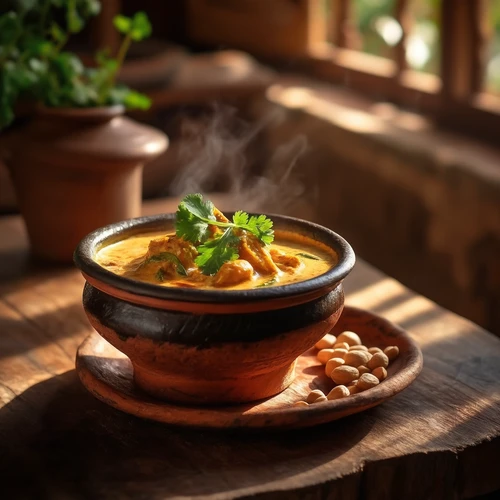The allure of slow‑cooked Thai cuisine lies in its ability to fuse bold spices, earthy herbs, and creamy coconut milk into comforting, soul‑warming dishes. Unlike quick stir‑fries, these meals evolve over time, allowing every flavor to mingle and deepen. Whether you’re simmering a savory Massaman curry with roasted peanuts or braising a fragrant tom kha soup with tender chicken, the slow‑cooked method brings out complexity that’s hard to achieve in minutes. Below is a detailed guide—including a classic recipe—to help you recreate these aromatic delights at home.
Choosing your base is the first step. Coconut milk is the standard for many Thai curries; its rich, sweet body balances the heat from chilies and the earthiness of spices. If you prefer a lighter touch, coconut cream or a mix of coconut milk and pandan‑infused broth can offer a subtler backdrop. Once your liquid base is set, the slow‑cook begins.
The golden rule of Thai slow cooking is low heat over several hours. This gentle simmer allows protein to become tender, caramelizes the sugar in spices, and lets aromatics release their essential oils. A slow cooker, Dutch oven, or a low‑heat stovetop pot are all suitable containers. Keep the lid partially ajar to let vapors escape and intensify the flavors.
Ingredients for Slow‑Cooked Massaman Curry:
- Chicken thigh, skin removed – 300 g
- Coconut milk – 400 g
- Ground cumin – 10 g
- Ground coriander – 8 g
- Ground cinnamon – 4 g
- Ground cloves – 2 g
- Ground cardamom – 1 g
- Red palm sugar – 15 g
- Light soy sauce – 20 g
- Fish sauce – 15 g
- Peanuts, roasted – 60 g
- Potato, peeled and cubed – 120 g
- Red onion, sliced – 70 g
- Thai chilies, sliced – 10 g
- Fresh coriander leaves – 5 g
- Lime, wedges – 60 g
- Cooked jasmine rice – 200 g (for serving)
Preparation steps:
1. In a dry skillet, toast the ground cumin, coriander, cinnamon, cloves, and cardamom over low heat until fragrant—about 30 seconds. Remove from heat and transfer to a mortar to crush slightly, creating a warm spice paste.
2. In a Dutch oven, combine the chicken, toasted spices, and a splash of coconut milk. Let the mixture sit for 15 minutes to allow the meat to absorb the spice aroma.
3. Add the remaining coconut milk, sweetened palm sugar, soy sauce, and fish sauce. Stir gently to dissolve any sugar.
4. Cover and simmer on very low heat for 2 to 3 hours, or until the chicken is fall‑apart tender. Stir occasionally, but avoid lifting the lid too often to keep the moisture locked in.
5. About 30 minutes before the end, stir in the cubed potatoes, sliced onions, and sliced chilies. Let them soften while retaining a slight bite—this contrast adds texture to the dish.
6. Just before serving, drop in the roasted peanuts, sprinkle freshly chopped coriander leaves, and serve with lime wedges. Pair the curry with hot jasmine rice for a complete meal.
Why slow cooking enhances Thai flavors
Thailand’s diverse landscapes—from the cool mountains of Chiang Mai to the tropical coasts of Phuket—contribute to its varied ingredient palette. Slow cooking allows each component, whether it’s a fragrant herb, a dry spice, or a delicate protein, to reach its full potential. The low heat lets the sugars in coconut milk caramelize gently, while spices release deeper, warmer notes rather than sharp, fleeting ones. The result is a dish that feels both comforting and richly layered.
Vegetarian option
For a plant‑based version, replace chicken with firm tofu and extra vegetables such as carrots (80 g) and bell peppers (60 g). Keep the same slow‑cook process; tofu will absorb the curry’s robust flavors, providing a satisfying bite.
Storage and reheating tips
Both meat‑based and vegetarian Massaman curry keep beautifully in the refrigerator for up to four days. Reheat gently over low heat on the stove or in a microwave, stirring occasionally. If the sauce has thickened, add a splash of water or coconut milk to restore the desired consistency.
Conclusion
Slow‑cooked Thai meals offer a unique culinary experience that marries aromatic tradition with comforting heat. By giving spices time to mature and proteins gentle tenderness, you unlock depth and harmony of flavors. Whether you’re a seasoned chef or a kitchen novice, this method invites you to explore Thai cuisine in a new, flavorful dimension.


